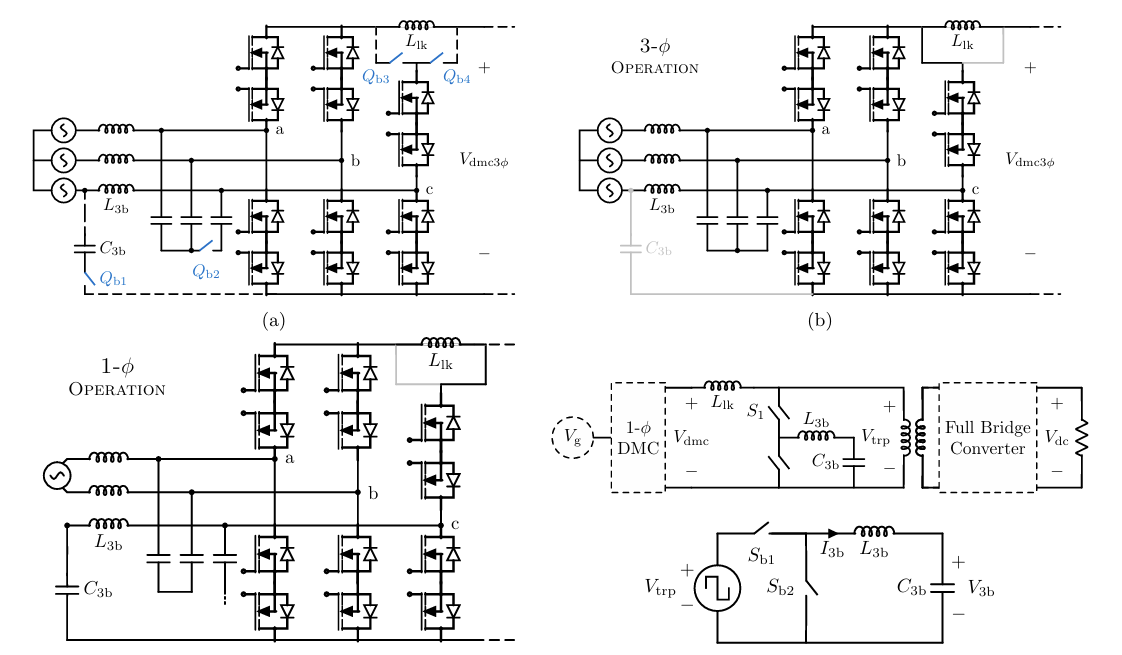The invention addresses the challenge of double line frequency energy in 1-ϕ operation of 3-ϕ-1-ϕ interoperable direct and indirect matrix converters. It proposes active power decoupling (APD) circuits that inhibit power pulsations using capacitors as energy storage elements. These APD circuits operate from the high-frequency AC (HFAC) link of the converters and are formed by repurposing redundant components of the 3-ϕ matrix converter during 1-ϕ operation, enhancing efficiency and stability.
Two topologies are proposed: a buck converter with a DC capacitor and a variant where the capacitor is connected to the low-frequency AC voltage neutral. The APD circuits improve power factor correction and harmonic elimination, suitable for bidirectional electric vehicle chargers and AC-DC converters. Key features include galvanic isolation via a high-frequency transformer, optimized component selection for minimized power loss, and soft switching conditions.
The invention can help realize efficient power management in AC-DC conversion systems by ensuring stable operation during 1-ϕ conditions and effectively managing power pulsations, ultimately enhancing overall system performance and reliability.
Figure (1) Schematic representation of an active power decoupling (APD) circuit, formed by reconfiguring the switches of the three-phase interoperable converter that are redundant during its one phase operation; (2) Schematic representation of a single-phase configuration of a three-phase interoperable direct matrix converter (DMC) with power decoupling arrangements); (3) Schematic depicting the overall configuration of the buck APD circuit, configuration during three phase operation, during one phase operation, basic circuit representation after reconfiguration, and equivalent circuit; (4) Schematic depicting the representation of another active power decoupling circuit that is connected to the low frequency AC side neutral, and simplified re-configuration of the circuit
Managing the double line frequency energy in 1-ϕ operation of 3-ϕ-1-ϕ matrix converters is challenging. This pulsating power can cause inefficiencies and instability in AC-DC conversions. Existing methods often fail to effectively mitigate these pulsations, especially when interfacing with high-frequency AC (HFAC) links in matrix converters.
There is a need for innovative active power decoupling (APD) circuits that can efficiently operate from the HFAC link of matrix converters. These circuits should absorb and mitigate the pulsating power, ensuring stable and efficient operation under varying load conditions, while minimizing additional costs and complexity.
- Ripple power compensation during 1-ϕ operation: This innovation utilizes APD circuits for managing pulsating 1-ϕ AC power by storing energy in capacitors, mitigating power pulsations effectively to enhance power quality and stability.
- High-frequency AC (HFAC) link operation: APD circuits operate at the HFAC link of the overall converter, reducing component stress and improving power management efficiency.
- Two proposed topologies: It includes a buck converter with a DC capacitor in parallel to the HF isolation transformer and a variant with the capacitor connected to the low-frequency AC voltage neutral, providing versatile options for AC power pulsation compensation.
- Repurposing existing matrix converter components: It converts redundant components during 1-ϕ operation into APD circuits, increasing system flexibility and functionality without additional components.
- High-frequency isolation transformer: It incorporates a high-frequency transformer for galvanic isolation, ensuring minimal power loss during AC to DC conversion.
- Soft switching and optimized component selection: It enables soft switching for converter elements, reducing switching losses, with optimized inductors and transformer turns ratio enhancing overall efficiency and reducing costs.
- Versatile applications: It is suitable for bidirectional EV chargers and AC-DC converters with HFAC links, ensuring efficient power management under fixed and variable power conditions.
The prototype comprises active power decoupling (APD) circuits for ripple power compensation in 3-phase to 1-phase interoperable high-frequency isolated bidirectional AC-DC converters. It operates at the high-frequency AC (HFAC) link, repurposes redundant components, and incorporates capacitors for energy storage. Key components include a high-frequency isolation transformer, switching converters, DC side terminals, DC capacitor, AC filter, and bidirectional switching elements. Operationally, it maintains galvanic isolation, optimizes power loss, adjusts duty ratios and phase shifts, ensures soft switching conditions, and integrates a DC capacitor for filtering. Modifications involve shifting the leakage inductor and using relays for reconfiguration.
3
This innovation actively decouples and compensates for power pulsations, minimizing energy losses during AC-DC conversion, leading to efficient energy utilization and reduced power consumption. It reduces harmonic distortions and voltage fluctuations, improving power quality and reliability for sensitive electronic devices, and decreasing the risk of equipment damage.
It reconfigures redundant 3-ϕ converter components to enable 1-ϕ operation, supporting dual-mode operation for applications like EV chargers, allowing high power charging in 3-ϕ mode and standard charging in 1-ϕ mode.
- Renewable energy
- Electric vehicles (EVs)
- Industrial automation
- Power electronics
- Smart grids
- Data centers
- Telecommunications
- Energy storage systems
Geography of IP
Type of IP
202321029926
484179




